The many types of sparrows are scattered like grains of salt over the earth.
These tiny birds are a familiar sight, and despite being small and unobtrusive, you will be amazed to discover that sparrows are fascinating birds and well worth a second glance.
Needless to say but the different types of sparrows are unique. In fact, even though they may look similar, many sparrows aren’t even related to each other.
We unravel the family ties and reveal some more interesting facts about sparrows.
Use this easy-to-follow guide to identify the types of sparrows in your area and learn more about species from around the globe.
Enter the fascinating world of sparrows and see the magic of nature right on your doorstep.

What Is A Sparrow?
You don’t need to be an ornithologist to be able to recognize some types of birds, but what exactly are sparrows?
There are so many sparrow types, and where exactly do they fit in the prolific kingdom of small gray and brown birds?
Although two distinct families are included under the umbrella term known as sparrows, these birds have common traits.
All sparrows are passerine birds. This means that, like many other bird types, they have feet adapted for perching.
All sparrows are a similar size, and most have mottled brown plumage. This has resulted in them frequently being affectionately referred to as LBJs (Little Brown Jobs).
Sparrows also all have distinctive conical-shaped bills that are adapted to crack seeds.
No matter what type of sparrow you see, you can be sure it is primarily granivorous. That means that its primary source of food is seeds.
In addition, sparrows also eat insects, which are a vital source of nutrients to feed their chicks. They are enthusiastic visitors to backyard bird feeders.
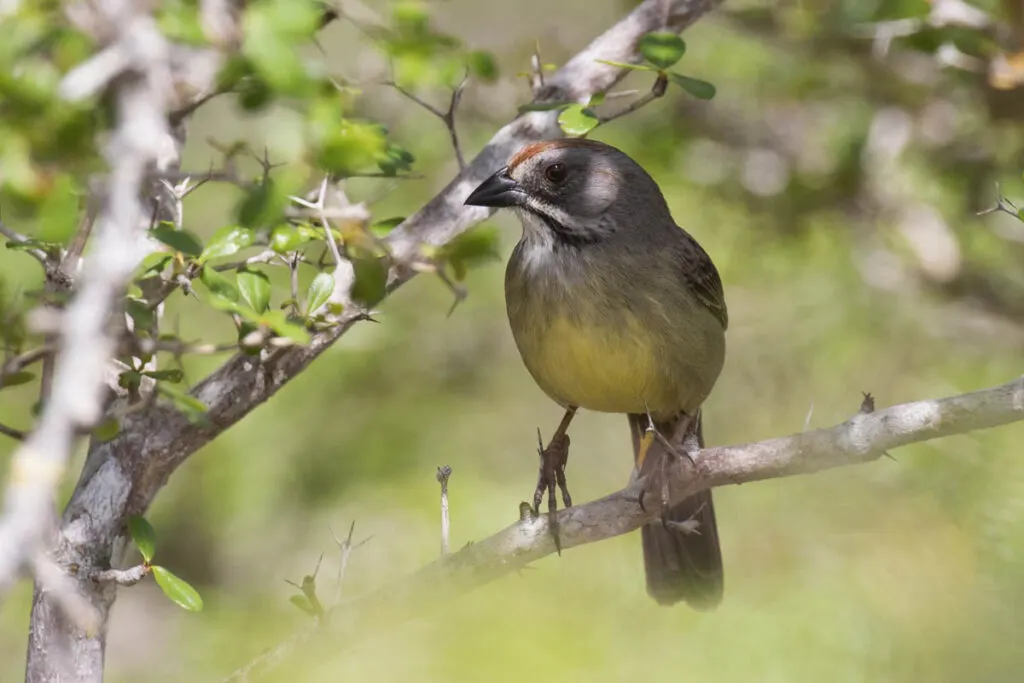
Sparrow Types
Now that we have covered some of the similarities of sparrows let’s look at the types of sparrows.
Not all sparrows are related, and they are either Old World Sparrows or New World Sparrows.
Although we may only recognize LBJs at birdfeeders in North America, there may be a combination of two entirely different families of birds.
Old World Sparrows
This group belongs to the group Passeridae which are called true sparrows.
There are 43 species in this family which are divided into eight genera. Native to Europe, Asia, and Africa, but have been introduced and are now widespread in North America and Australia.
New World Sparrows
These types of sparrows belong to the family Passerellidae. These passerine birds are more closely related to finches and buntings than Old World sparrows.
There are 138 species in this large family, which is native to all parts of the Americas. Their range begins in the arctic tundra and extends through to the southern tip of South America. They occupy every type of habitat, from tropical rainforests to hostile deserts.
18 Different Types of Sparrows
Now that we have covered the family groups, let’s check out some types of sparrows you may see. Get your binoculars ready, and let’s start sparrow-watching!
Old World Sparrows
1. Desert Sparrow
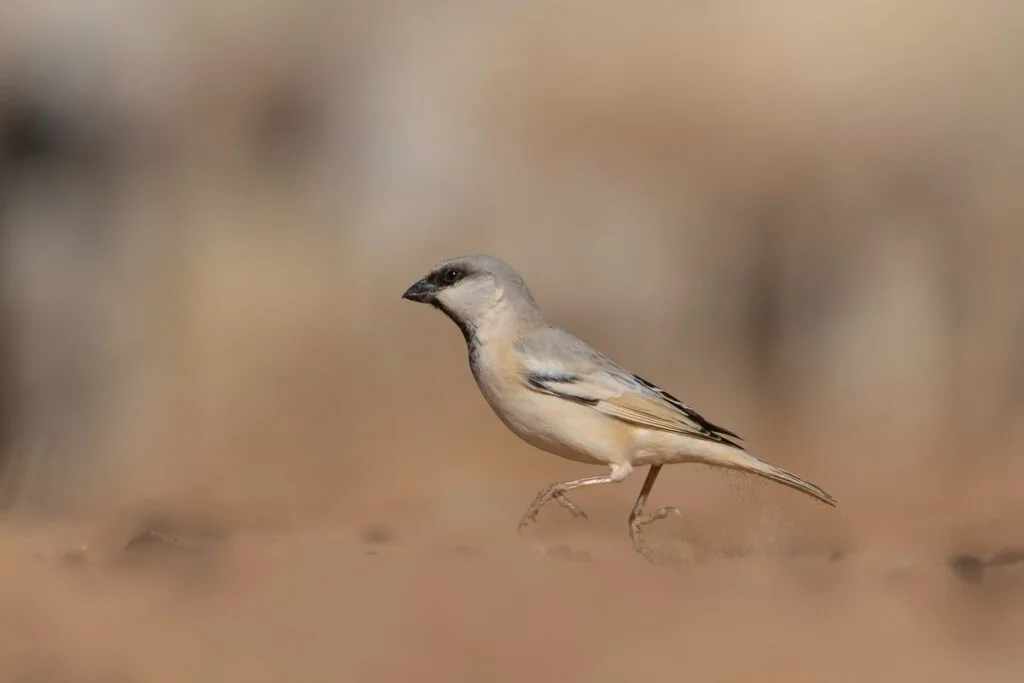
Desert sparrows (Passer simplex) are distributed over the Sahara, an African desert that happens to be one of the largest deserts in the world.
Since this region is one of the driest places on earth, vegetation is minimal, so these small sparrows have adapted to nesting on the dunes or sharing accommodation with humans and nesting in mud walls.
Fortunately, inhabitants in desert regions welcome desert sparrows, and in some areas, inhabitants create holes on the outside of their walls specifically to accommodate them.
This desert bird is regarded as a sign of good tidings if a desert sparrow sings in the house.
The environment in the desert is pretty hostile, so desert sparrows have adapted to moving about in search of food sources like insects and seeds. As expected, they tend to gather around water sources.
Male desert sparrows have dark faces, bibs, and bills, while females are paler and have more of an overall sandy color.
Desert sparrow calls are quite deep and are a simple mechanical ‘churp’ sound.
Although desert sparrows are classified as a species of least concern, these small desert inhabitants are increasingly threatened by common house sparrows who out-compete them for nesting space.
Since desert sparrows are small and delicate, conservation efforts focus on providing nesting boxes with openings too small to accommodate house sparrows.
Read next: 15 Smallest Birds in the World
2. House Sparrow
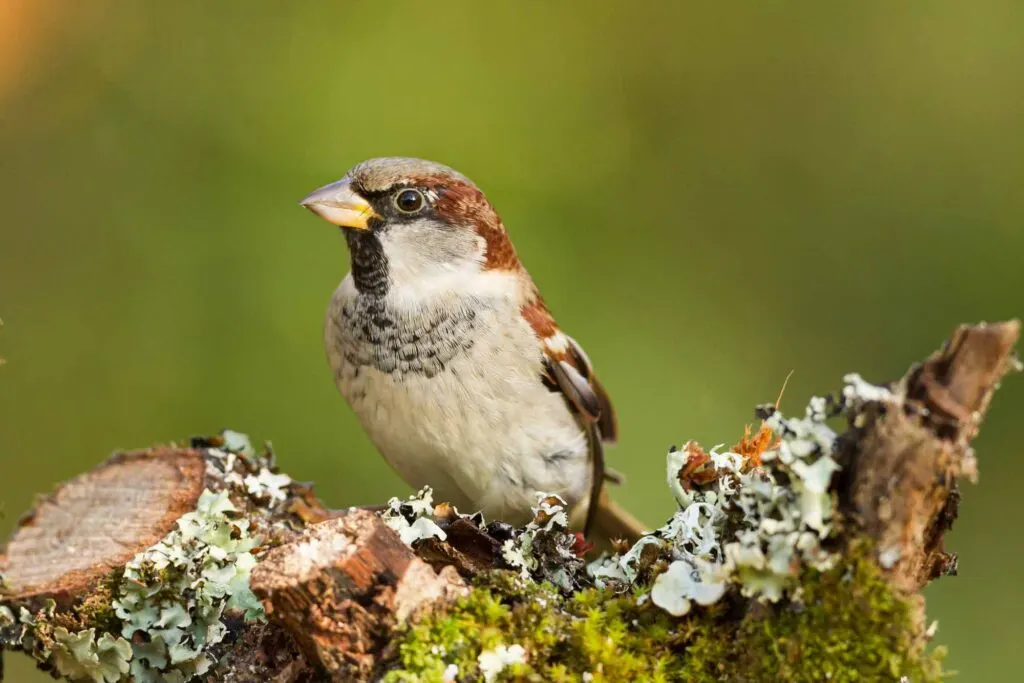
House sparrows (Passer domesticus) are Old World sparrows that thrive in urban settings.
Although these birds originated in the Middle East, they have spread via gradual expansion and introduction to Africa, all parts of the Americas, Australia, and New Zealand. House sparrows are the most widely distributed of all wild birds.
The success of house sparrows is their adaptability and assertive manner. They aggressively defend their nests, and in North America, they are also known for chasing native birds from nest boxes.
These champions of survival are opportunistic, and although their preferred diet is seeds, they will also take insects and even scavenge through garbage for titbits.
House sparrows are sexually dimorphic, so it is easy to tell the males and the females apart. Males have darker heads and a striking black patch around their bill and down the throat.
Female house sparrows are much duller and have buff color plumage on the upper and lower parts of the body.
They are slightly smaller than males, but on average, the species weigh between 0.85 – 1.39oz.
3. Rock Sparrow
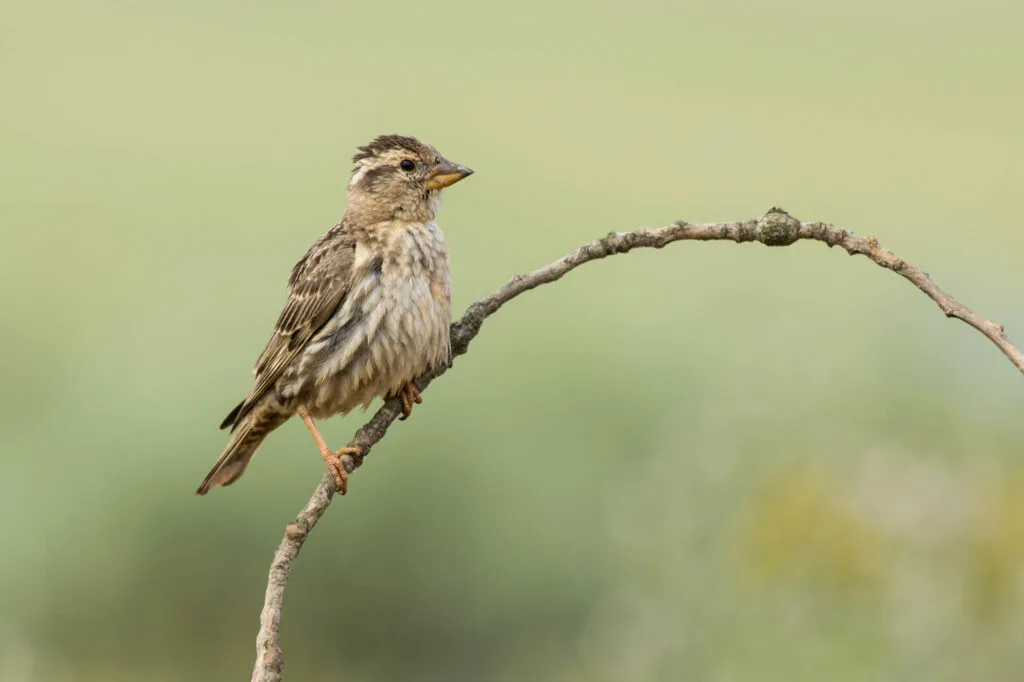
Rock sparrows range from North Africa into Southern Europe and across Asia.
Although they are a stereotypical-looking brown streaked sparrow, this Old-World variety has a distinctive sounding ‘vui’ call. The song has been described as sounding wheezy.
In appearance, rock sparrows look a lot like buff brown female house sparrows.
To tell the species apart, you need to study the shape of their body. Rock sparrows are considerably shorter, bulkier, squarer shaped, and with conical bills.
Seven rock sparrow subspecies are spread across the vast range of these birds.
Males and females are similar, and their average length from the beak to the end of the tail is around 5.5 inches.
Rock sparrows spend their days searching for seeds on the ground.
During the breeding season, they step things up and take insects and caterpillars, which they also feed to their hatchlings.
In autumn, they are likely to add berries if they are available.
4. Rufous-Necked Snowfinch
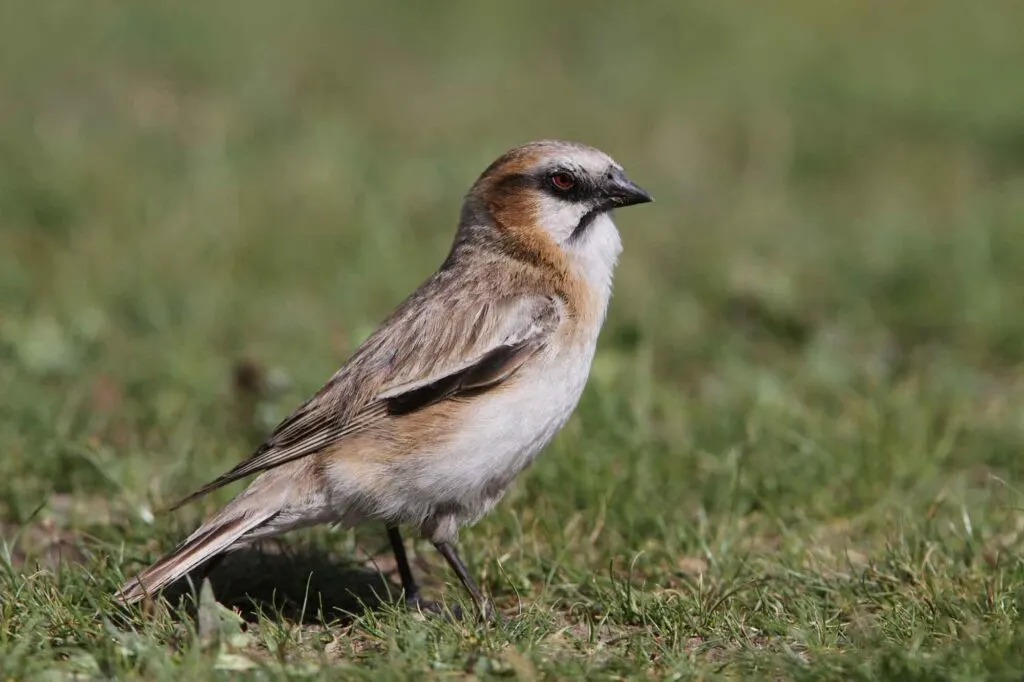
Moving over to the East, we find another interesting species of sparrows. Rufous-necked snowfinches are, in fact, sparrows, and they occur in Tibet and the central and western regions of China.
The rufous-necked snowfinch (Pyrgilauda ruficollis) is an unremarkable-looking, small sparrow that tends to stay within particular regions throughout the year.
These tiny sparrows are not great long-distance fliers, so they tend to adjust altitude in their mountainous habitat in response to inclement weather rather than getting away from it entirely.
Male and female rufous-necked snowfinches are monomorphic.
They measure around 5.9 inches in length and are quite colorful compared to other types of snowfinches. They weigh between 0.81 – 0.98oz.
This Old World species is named for the reddish-brown plumage on the sides of its faces, which spreads down its neck.
Rufous-necked snowfinches have black lores and bills that make their faces stand out.
Seeds and insects are the main diet of this type of sparrow. Rufous-necked snowfinches feed off the ground and be seen foraging in flocks.
They have a social, soft, chattering call, although they can make louder buzzing noises during flight.
5. Yellow-Spotted Bush Sparrow
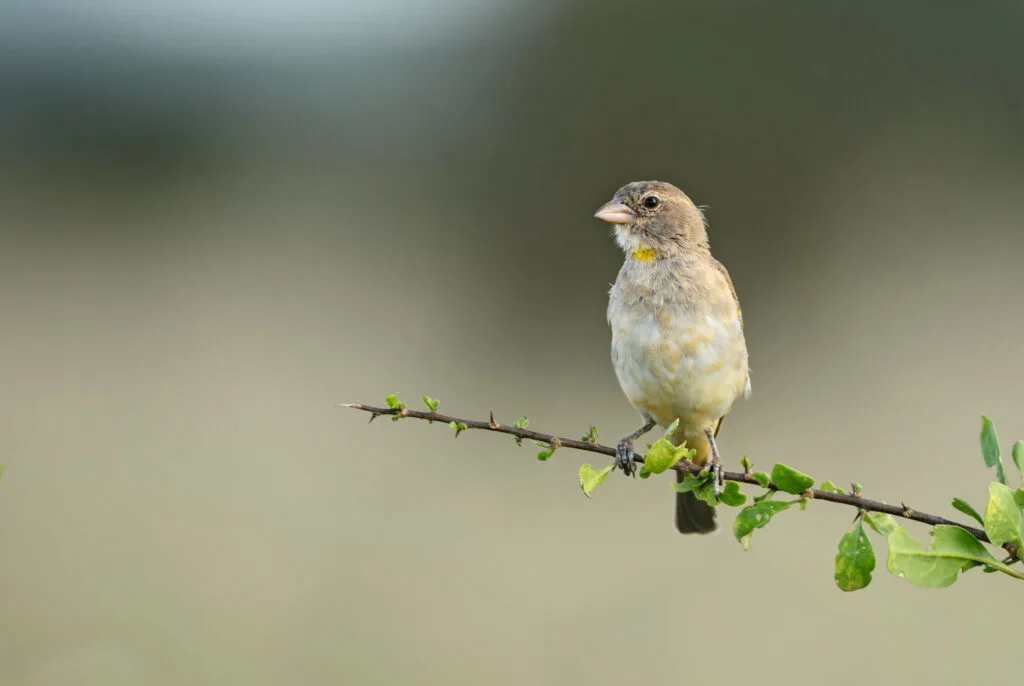
It can be difficult to see the faint yellow spot on the throats of yellow-spotted bush sparrows (Gymnoris pyrgita).
These gray-brown Old World sparrows are perfectly camouflaged against the dry thorn savanna habitat they call home.
Yellow-spotted bush sparrows occur in the Sahel belt of Africa. By far, the largest density of these birds is in the horn of Africa.
They thrive in dry areas and dry grasslands and tend to move around nomadically in search of food.
Males and female yellow-spotted bush sparrows are similar in appearance. These are not standout birds; they blend perfectly in their arid surroundings.
They weigh around 0.74 – 1oz and are 6 inches in length.
Yellow-spotted bush sparrows forage on the ground and in trees and shrubs.
One of their primary food sources is berries from the delightfully named toothbrush tree that grows in the region. They also feed on seeds and insects and can often be found in flocks.
6. Russet Sparrow

The title of most musical sparrows in the family belongs to the russet sparrows of eastern Asia and the Himalayas.
They have the basic monosyllabic call like most other sparrows, but occasionally, males of the species will string together a whole range of sounds to create interesting melodic songs.
Russet sparrows (Passer cinnamomeus) are similar in appearance and habit to house sparrows.
Like their widespread cousins, these tiny birds are dimorphic. Adult males have a striking red russet top layer, a small black bib under their chin, and white undersides.
Because of the rusty coloring, these sparrows are also often called cinnamon sparrows.
Female russet sparrows are less eye-catching. They have brown upper bodies and are pale underneath.
They have very pretty dark brown stripes that run through the eyes and blend in with the rest of the plumage on the neck. Adult russet sparrows weigh between 0.63 – 0.79 oz.
Since russet sparrows feed mainly on seeds and grains and inhabit agricultural areas, they are considered pests in some places.
However, they reduce insect pests on plants, especially in warmer months when they feed their young. These sparrows have a very short breeding season of only three months.
7. Eurasian Tree Sparrow
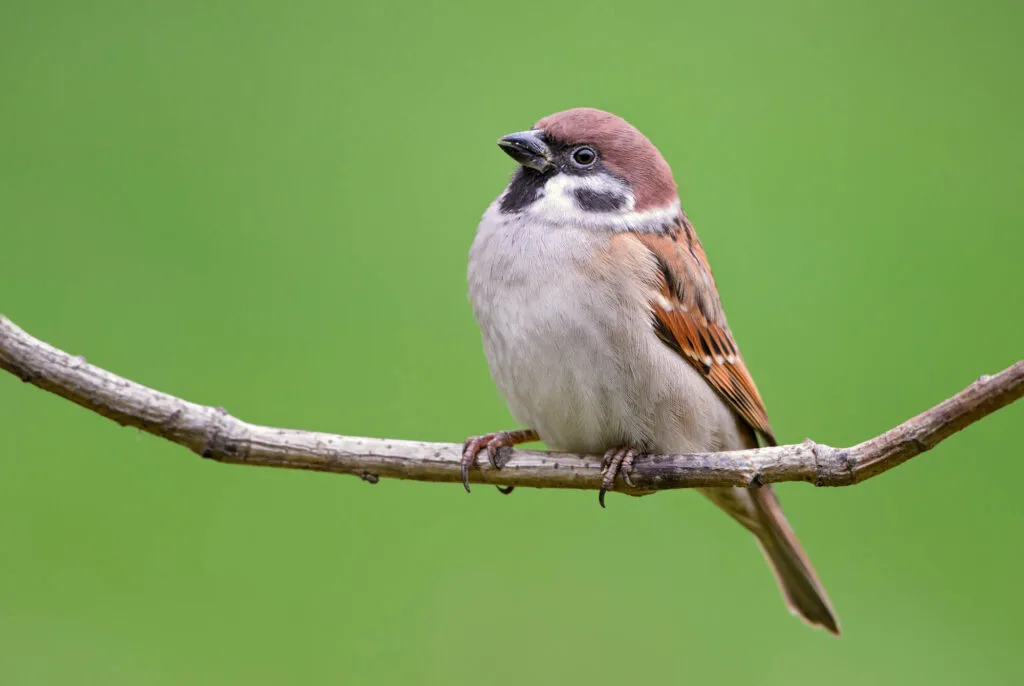
The final bird in our whirlwind tour of some types of sparrows is the unique Eurasian tree sparrow (Passer montanus), an Old World sparrow species with an extensive range.
These tiny birds breed throughout Eurasia and southwest Asia. They have also been introduced to North America, where it is sometimes also referred to as the German sparrow to avoid confusing it with the American tree sparrow.
Although the range of Eurasian tree sparrows in their native territory in Europe and Asia is immense, there is little variation in appearance.
The group of twelve birds that were released in Missouri in 1870 have, however, changed and are significantly larger and have developed different calls to their European ancestors.
Eurasian tree sparrows are sexually monomorphic, so it is almost impossible to tell males and females apart from their plumage.
These sparrows feature a nape and crown of warm chestnut. They have dark patches behind each ear, on their chin, and down their throat that stands out on their white undersides. The average weight of adult birds is around 0.85oz.
Like many types of sparrows, Eurasian tree sparrows mainly feed on seeds and grains with the occasional addition of insects.
They readily use backyard feeders. These tiny birds have the unfortunate distinction of having a predator named after them – the Eurasian sparrowhawk.
Fortunately, these birds of prey don’t specifically target Eurasian sparrows.
New World Sparrows
8. Vesper Sparrow
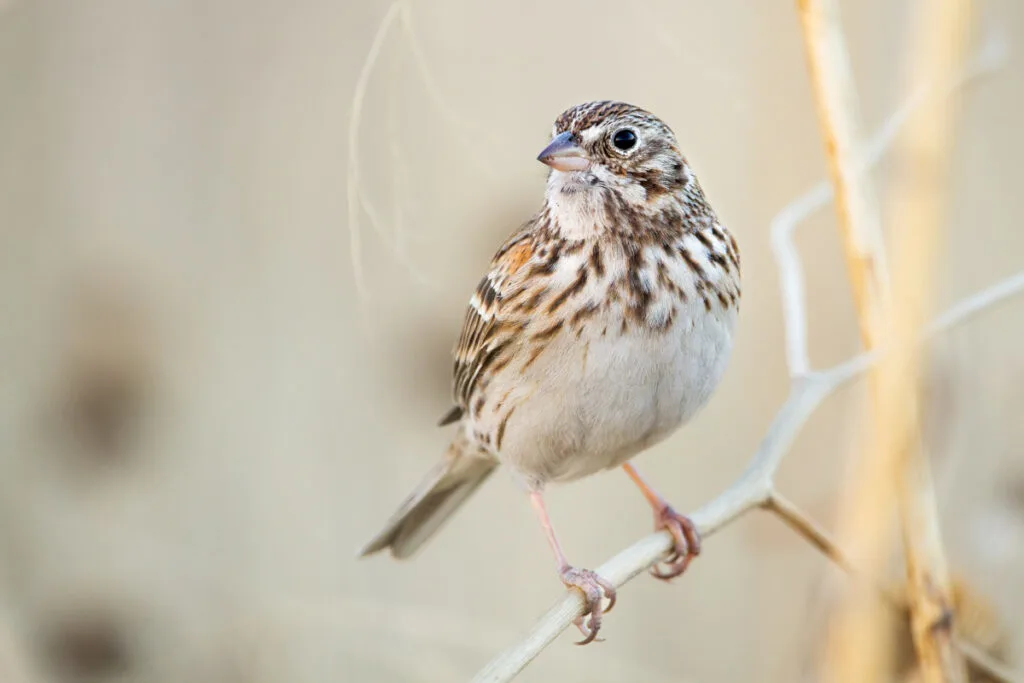
The next New World sparrow we will learn to identify is the vesper sparrow (Pooecetes gramineus).
Their delightful name resulted from their characteristic singing into the evening, which is reminiscent of evening vespers.
The vesper sparrow is unique in its class as it is the only type in its genus. These sparrows are specifically grass dwellers and are only found in fields, meadows, and grasslands across North America. They may fall prey to some types of falcons, including the American kestrel.
To identify vesper sparrows, look for the tiny patch of chestnut at the top of their shoulders.
These streaky brown and white birds also have noticeable white flashes in their tails and narrow white eye rings.
Male and female vesper sparrows are identical. Their average weight is between 0.7 and 1.0 ounces. Male vespers can be noted perched on a pole or in elevated positions while singing.
Vesper sparrows are often observed foraging on the ground, especially around shrubs where they collect seeds and insects.
Outside of the breeding season, they frequently collect in an area in small social groups.
9. Song Sparrow
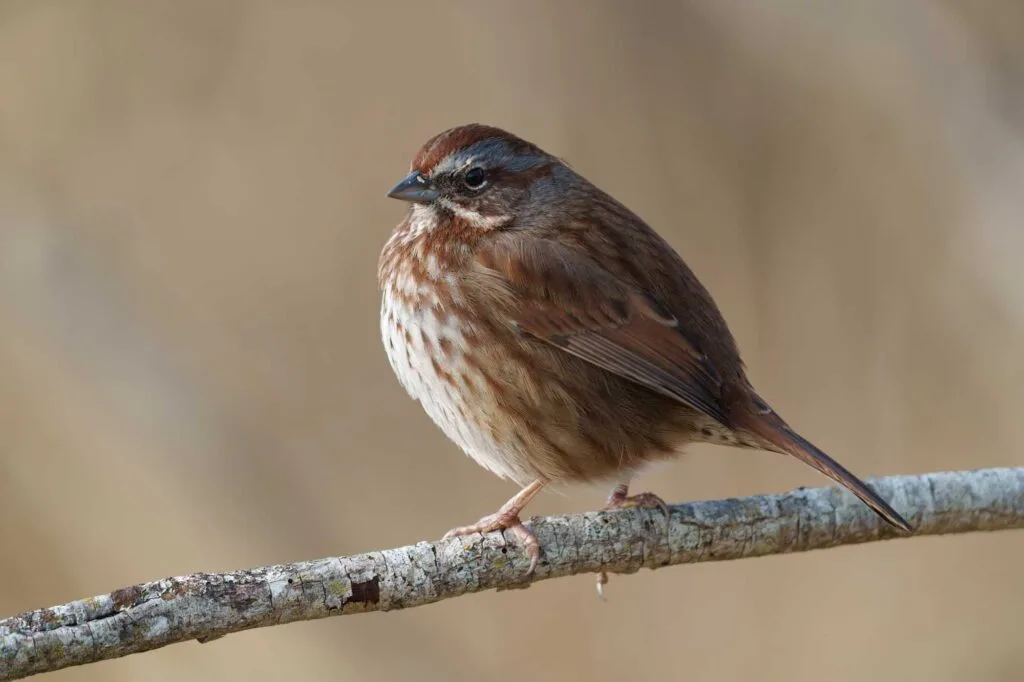
The energetic song sparrow is one of North America’s most common birds. No matter where you live, chances are good that you will have one nearby.
As its name suggests, the song sparrow (Melospiza melodia) is often heard before they are seen.
Males serenade the ladies with a repertoire of songs. They can create at least twenty different tunes, which are a combination of sharp notes and thrills.
Male and female song sparrows are identical. The average weight is 0.42 – 1.87 ounces.
These sparrows are common in all areas, but it can be tricky for novice bird watchers to identify them because they exhibit regional color differences.
In general, song sparrows have brown upper bodies and creamy color underparts with dark streaks running downward and a visible brown spot in the center of the chest. The physical variation between birds in different areas is significant.
Desert groups are often lighter, Pacific Northwest song sparrows are heavily streaked and much darker, and the Alaskan song sparrows are almost twice the size of their southern counterparts.
Song sparrow nests may be hidden in the grass, on the ground, or in high shrubs.
Female song sparrows build sturdy cup-shaped nests out of grass and weeds and line them with animal hair and softer grass.
10. White-Crowned Sparrow
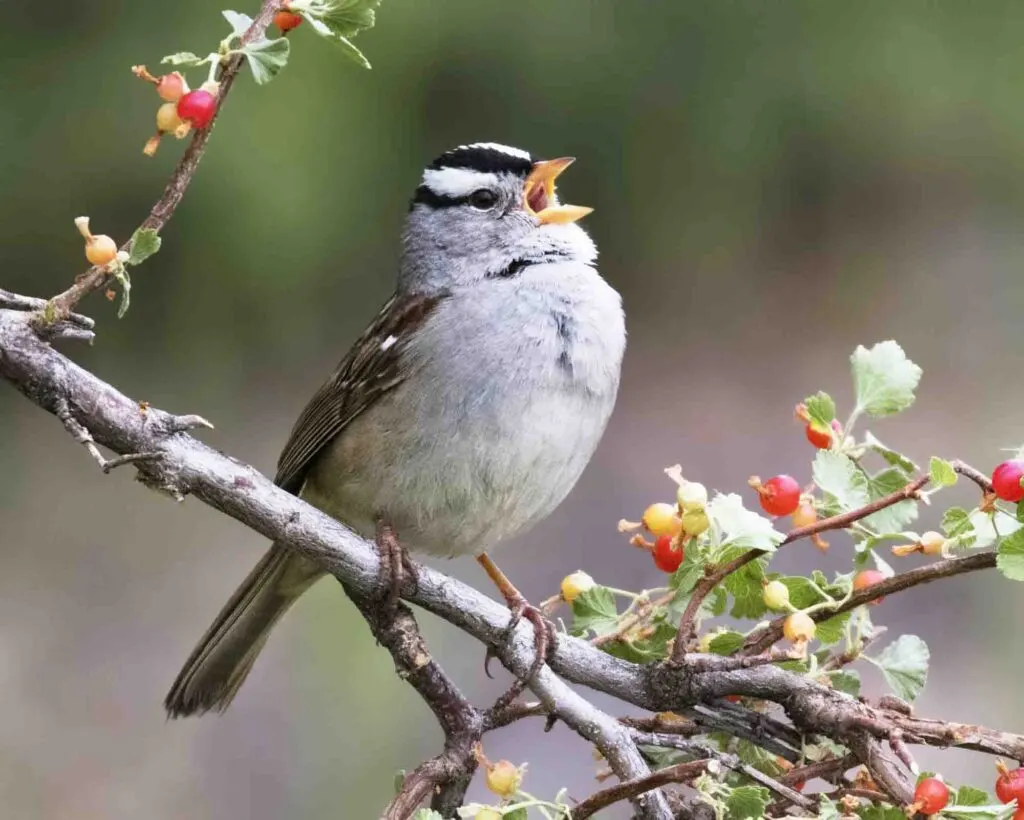
The white-crowned sparrow (Zonotrichia leucophrys) is one of the easiest sparrow types to identify.
These New World brown sparrows have distinct black and white striped patterning on their head and a long tail sticking out from their brown body.
This type of sparrow is migratory and only a visitor to the United States during winter.
In warmer months, this eye-catching sparrow type heads north back to the furthest most northern parts of the continent to breed amongst the scrubby bushes in the taiga and tundra.
Adult, white-crowned sparrows are monomorphic. That means that they are the same size and have the same plumage. The average weight of a white-crowned sparrow is 0.9-1.0oz.
Like other types of sparrows, white-crowned sparrows are predominantly seed eaters. They can be observed during winter foraging in areas in flocks.
These pretty sparrows also make short, low flights over their grassy habitats to catch insects out of the air.
11. Sooty Fox Sparrow
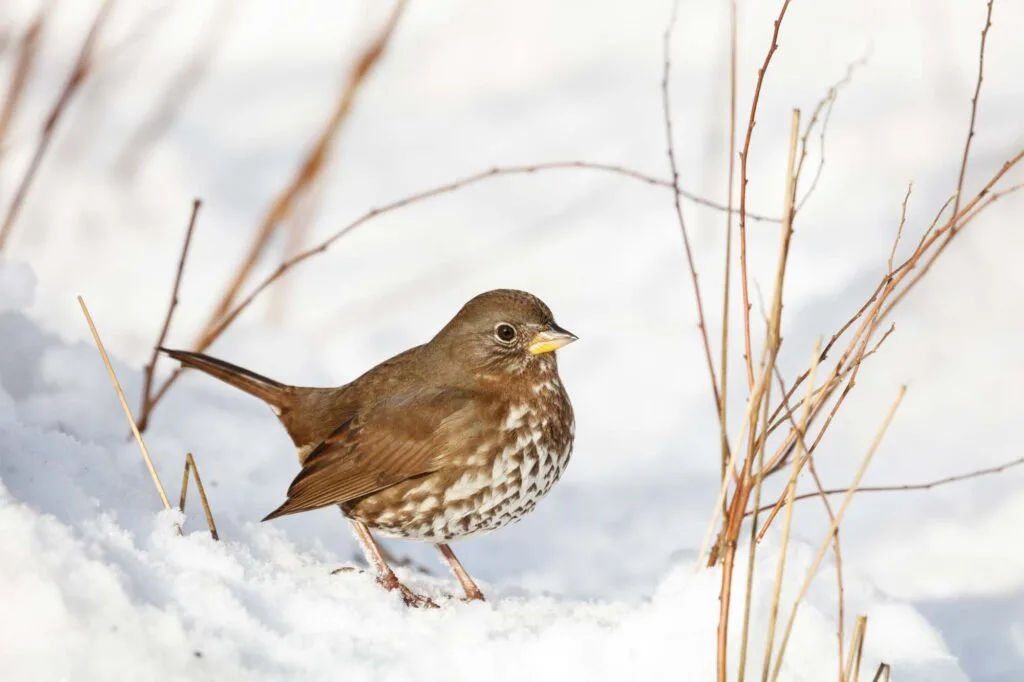
If you live along the West Coast of North America, look out for the sooty fox sparrow.
This species, which displays considerable diversity in color from north to south, is the darkest sparrow type.
It has the extremely long and tongue-twisting scientific name: Passerella (iliaca) unalaschcensis.
Sooty fox sparrows are a subspecies within the broader family of fox sparrows, of which there are several variations.
The average weight of fox sparrows is 0.9 – 1.6oz, and males and females are physically identical.
Like all fox sparrows, sooty fox sparrows can be found in dense forests and mountain scrubs during the breeding season.
These dark-colored birds spend a lot of time on the ground foraging through fallen leaves for seeds and insects.
They can often be observed on the ground below the feeder, picking up dropped seeds at bird feeders.
12. Grasshopper Sparrow
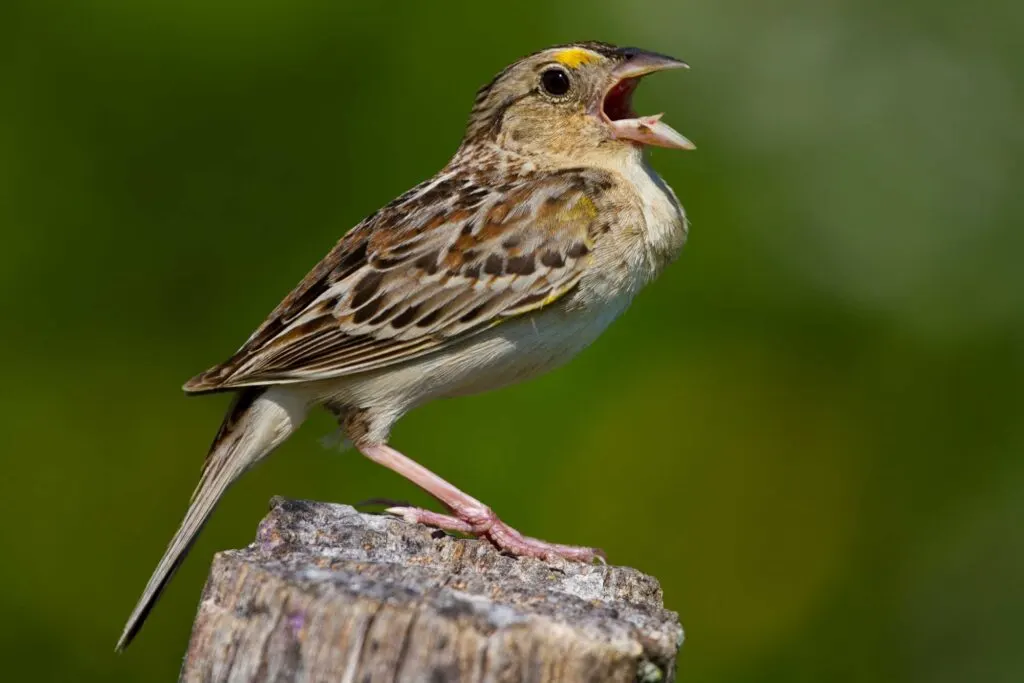
Grasshopper sparrows are an elusive variety that you are more likely to hear rather than see.
These tiny New World sparrows can be found in grasslands and prairies across southern Canada and down into central and eastern regions of the United States.
As their name suggests, grasshopper sparrows (Ammodramus savannarum) feed mainly on grasshoppers and other insects.
Although grasshopper sparrows are migratory birds, they aren’t the best day-to-day flyers of their family, and they often scurry around hunting in long grass-like rodents rather than birds.
Males and females are monomorphic, and the average weight for the species is 0.60oz.
They are streaked with black, white, gray, and brown plumage, which offers excellent camouflage for the birds while they are nesting. Both females and males have an orange or yellow stripe above their eyes.
Grasshopper sparrows build nests on the ground. Females build well-hidden dome-shaped nests in patches of long grass.
These sparrows are unique in that they sing two different songs; one is a dry buzzing sound, and the other is a more musical bird song.
13. Dark-Eyed Junco
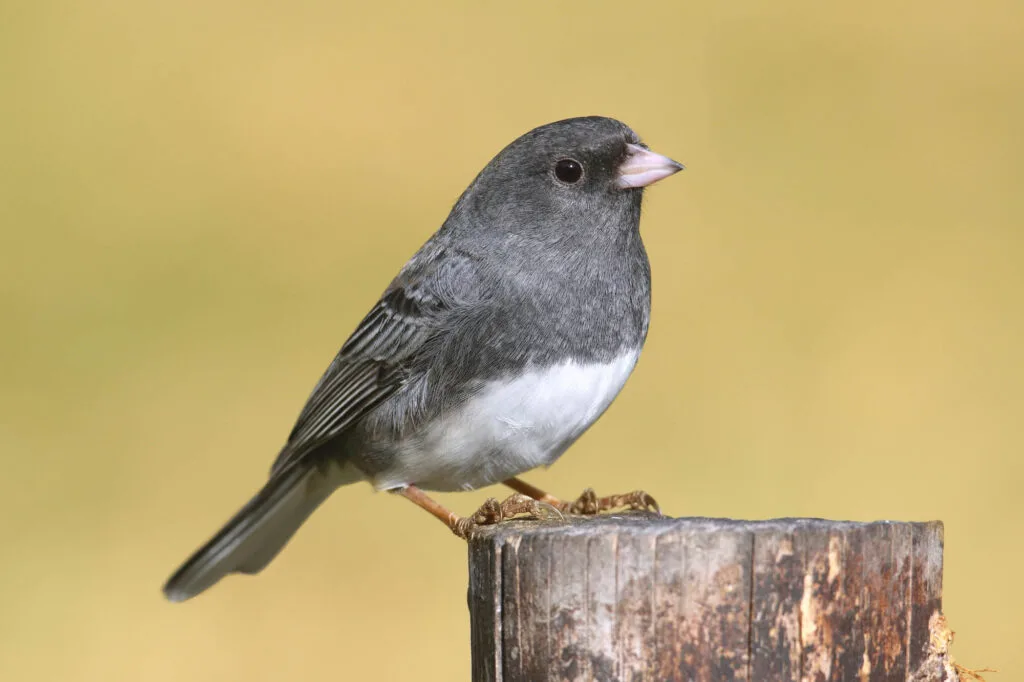
Breaking from the mold of streaky-brown sparrow plumage, the gorgeous dark-eyed juncos have distinctive-looking dark gray or brown bodies with easy-to-spot white outer tail feathers.
These small New World sparrows are abundant in all parts of North America, and you are most likely to spot them darting about on forest floors.
Dark-eyed juncos (Junco hyemalis) spend the summer months in northern parts of Canada and Alaska.
Dark-eyed juncos, also frequently called snowbirds since their arrival in the United States coincides with the start of winter, have several color morphs.
There are at least 14 different types of sparrows within this species. The rich gray variation is called slate.
Other subspecies variations include Oregon, which features a dark hood, red-backed, pink-sided, gray-headed, and white-winged.
Males often have darker plumage and are more conspicuous than females. The average weight of these sparrows is between 0.63 – 1.06 oz.
14. Field Sparrow
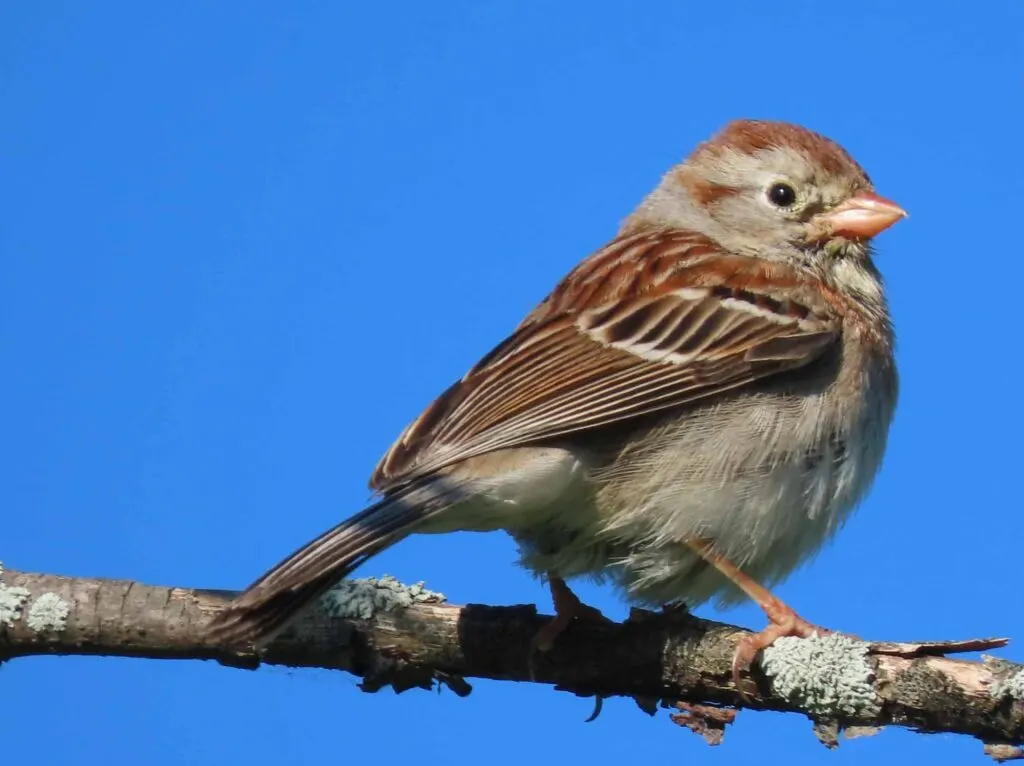
Field sparrows are tiny New World sparrows that range from eastern Canada and south into northern Mexico.
As you can tell from their name, their preferred habitat is prairies and fields, and they do not adapt well to urban areas.
This has resulted in a sharp decrease in their numbers as suburbs continue to sprawl across their range.
These small sparrows are mostly brown and white, with dark brown streaking over their shoulders.
They have forked tails and pink bills. Their average weight is 0.44oz, and although there is no difference in the plumage, males are frequently slightly larger than females.
Field sparrows are ground feeders that hop about looking for seeds and insects in areas where there is low vegetation. They can often be seen foraging in small flocks.
Male field sparrows tend to sing more enthusiastically while trying to attract a mate. Once he has accomplished the task, he will sing less often.
Field sparrow suitors can most often be observed early in the morning when they are most likely to be serenading from conspicuous perches.
15. American Tree Sparrow

For a sparrow that is called a ‘tree sparrow,’ these tiny birds seldom go into trees. The name came about because it reminded early American settlers of European tree sparrows.
American tree sparrows (Spizellloides arborea) are another example of snowbirds that arrive in the United States as temperatures cool down.
Come spring, they fly north to their breeding grounds which is the tundra in the far north regions of the continent.
Males and female American tree sparrows are monomorphic. The average weight of these birds is 0.5-1.0os, and they have pretty rust color caps, rusty backs, and long, thin tails.
While looking for them, look out for the dark spot on their pale gray chests.
Unlike many other types of sparrows, American sparrows eat seeds, insects, and berries. All food is taken from the ground.
They need to eat at least 30% of their body weight daily to survive, and even one day without food can be fatal.
16. White-Throated Sparrow
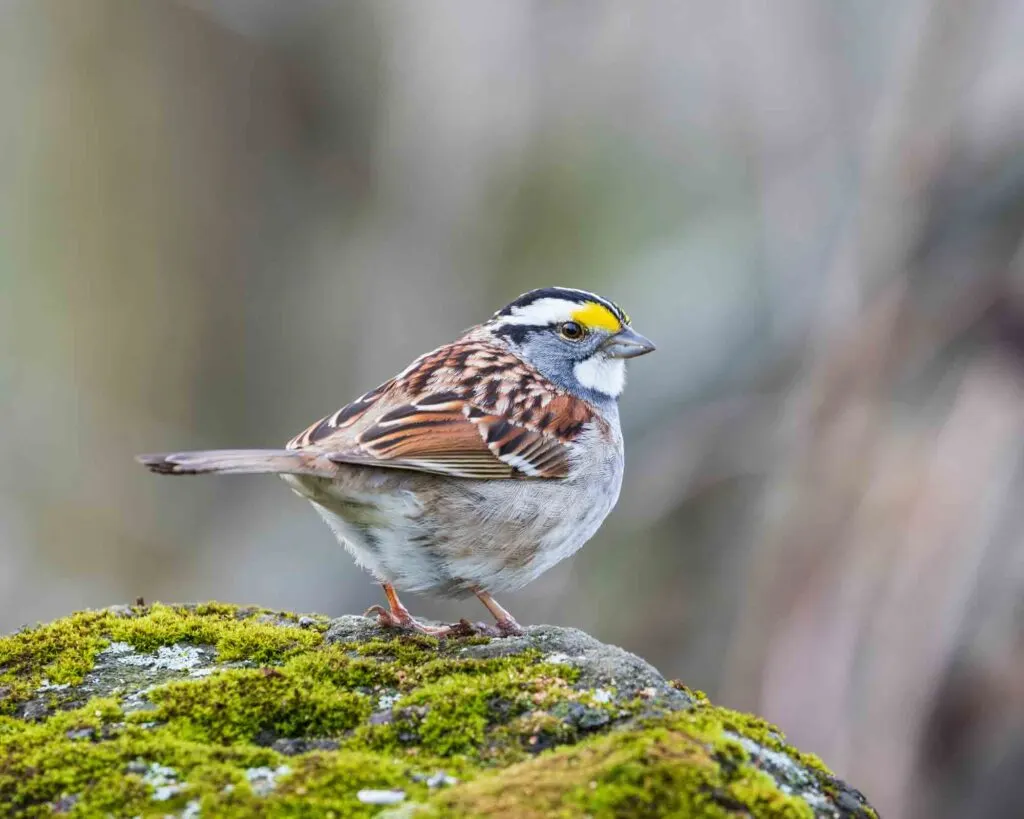
The white-throated sparrow (Zonotrichia albicollis) is one of the easiest types of sparrows to identify.
Although it comes in two color morphs, both share distinctive black and white stripes on their heads and yellow lores – that is, in the region between the bill and the eyes.
White-throated sparrows are New World sparrows that only breed in Canada and New England.
During winter, they move south and can be found foraging in large flocks on the ground in woods and forest edges.
They are also ready visitors at bird feeders, where they pick up fallen seeds on the ground.
Male and female white-throated sparrows are similar in appearance. There are two distinct color morphs, the white-striped and tan-striped varieties, that occur in equal numbers.
Individuals of each form consistently mate with birds of the opposite form. Their average weight is 0.78 to 1.13 oz.
White-throated sparrows typically nest on the ground, although they may attempt to nest in conifers if they have had an unsuccessful attempt on the ground.
This sparrow type is frequent and enthusiastic for visitors at bird feeders during winter. Their diet consists of seeds, insects, and berries.
17. Golden-Crowned Sparrow
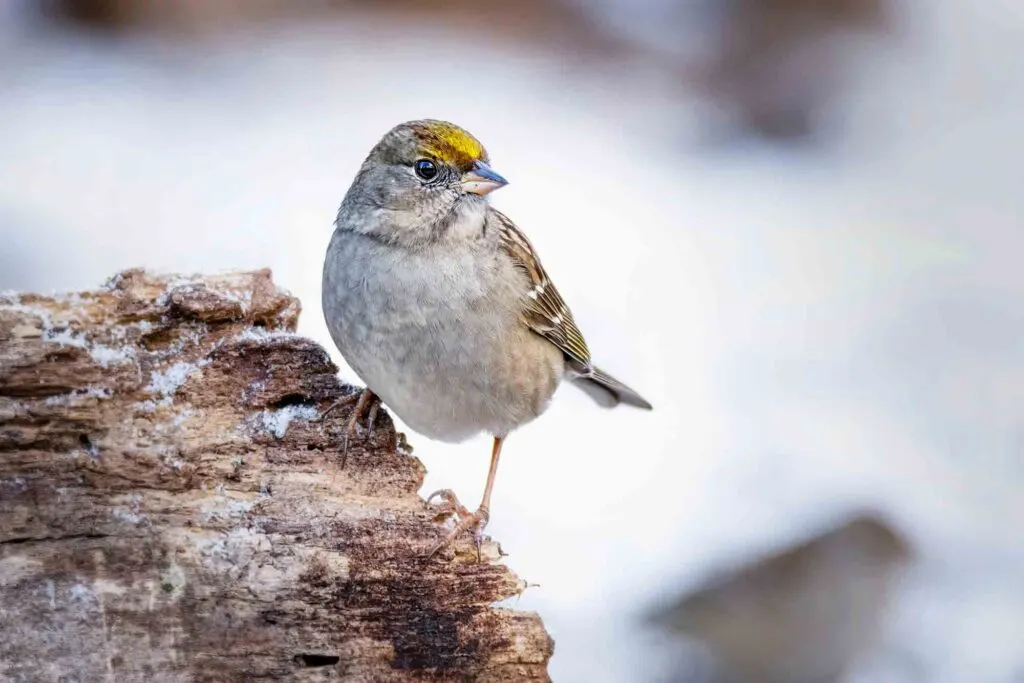
When bird watching in winter along the Pacific coast, look out for the bright yellow crown of the golden-crowned sparrow (Zonotrichia atricapilla).
These New World sparrows have very attractive distinguishing dark and gray plumage on their head. The rest of their bodies is reminiscent of most other sparrow types.
The golden-crowned sparrow is not a picky eater and will nibble on anything from the usual sparrow fare of seeds and insects to flower buds, blooms, and even vegetables in gardens.
Fortunately, veggie patches are safe during the summer months as these pretty sparrows head far north to breed in remote tundra areas.
Male and female golden-crowned sparrows are similar in appearance, and their average mature weight is between 0.67 and 1.25 oz.
Their plumage changes during breeding season when the broad yellow central stripe fades to become grayer behind the head.
Not a lot of research has been done about the nesting behavior of this species, but we do know that they build nests on the ground and that the young fledge remarkably quickly.
From hatching completely helpless and blind, chicks fledge within 12 days.
18. Lark Sparrow
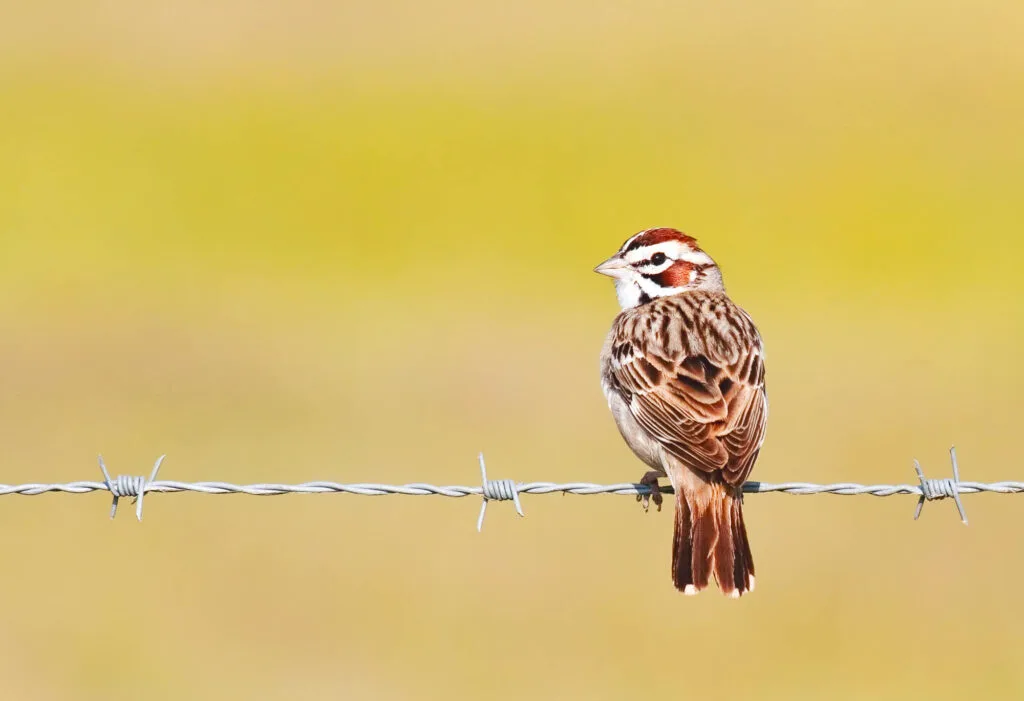
Look out for lark sparrows (Chondestes grammacus) in the central and western regions of the USA.
Unlike many other types of sparrows, this species of New World sparrows spend summer in the US and breed in grasslands and open countryside settings.
Lark sparrows are attractive, large sparrows with dark harlequin stripes covering their faces.
Although their bodies are the usual streaky sparrow brown, they have noticeable white tail spots that make recognition easier.
These large types of sparrows weigh an average of 0.8-1.2oz. Males and females have similar striking patterning and can commonly be seen foraging on the ground.
Although their main diet is seeds, they will increase their intake of insects during the breeding season.
The courtship behavior of male lark sparrows is unique. Instead of singing to attract potential mates like most other species, lark sparrows perform a hopping dance.
Moves include tail spreading and a turkey strut movement. Performances can last up to five minutes.
Sparrow Types FAQ
What Are Sparrows?
Sparrows are small passerine birds with common traits such as adapted feet for perching, most have mottled brown plumage and conical-shaped bills for cracking seeds.
How Many Types of Sparrows Are There?
Sparrows can be categorized into two main groups: Old World Sparrows and New World Sparrows. There are 43 species of Old World Sparrows and 138 species of New World Sparrows.
What Are Old World Sparrows?
Old World Sparrows belong to the Passeridae family and are true sparrows. They are native to Europe, Asia, and Africa but have been introduced and are widespread in North America and Australia.
What Are New World Sparrows?
New World Sparrows belong to the Passerellidae family and are more closely related to finches and buntings than Old World sparrows. They are native to the Americas and occupy various habitats, from tropical rainforests to deserts.
Can Sparrows Be Found Worldwide?
Yes, sparrows can be found worldwide, with different species inhabiting different regions.
What Are Some Types of Sparrows?
Some types of sparrows include the Song Sparrow, Vesper Sparrow, White-Crowned Sparrow, Sooty Fox Sparrow, Chipping Sparrow, Clay-Colored Sparrow, Grasshopper Sparrow, Savannah Sparrow, Saltmarsh Sparrow, Black-Throated Sparrow, Dark-Eyed Junco, Field Sparrow, American Tree Sparrow, White-Throated Sparrow, Golden-Crowned Sparrow, and Lark Sparrow.
How Can I Identify a Song Sparrow?
Song Sparrows have brown upper bodies, creamy underparts with dark streaks, and a visible brown spot in the center of the chest. They exhibit regional color differences, and their nests can be hidden in the grass, on the ground, or in shrubs.
What Is Unique About Vesper Sparrows?
Vesper Sparrows are grass dwellers found in fields, meadows, and grasslands. They have a tiny patch of chestnut at the top of their shoulders and noticeable white flashes in their tails and eye rings.
How Can I Recognize a White-Crowned Sparrow?
White-Crowned Sparrows have black and white striped heads, long tails, and brown bodies. They are migratory and visit the United States during winter. They predominantly eat seeds, insects, and berries.
Hey, did you enjoy learning about the different types of sparrows? Then share this article with your friends!
18 Different Types of Sparrows
1. Desert Sparrow
2. House Sparrow
3. Rock Sparrow
4. Rufous-Necked Snowfinch
5. Yellow-Spotted Bush Sparrow
6. Russet Sparrow
7. Eurasian Tree Sparrow
8. Vesper Sparrow
9. Song Sparrow
10. White-Crowned Sparrow
11. Sooty Fox Sparrow
12. Grasshopper Sparrow
13. Dark-Eyed Junco
14. Field Sparrow
15. American Tree Sparrow
16. White-Throated Sparrow
17. Golden-Crowned Sparrow
18. Lark Sparrow
